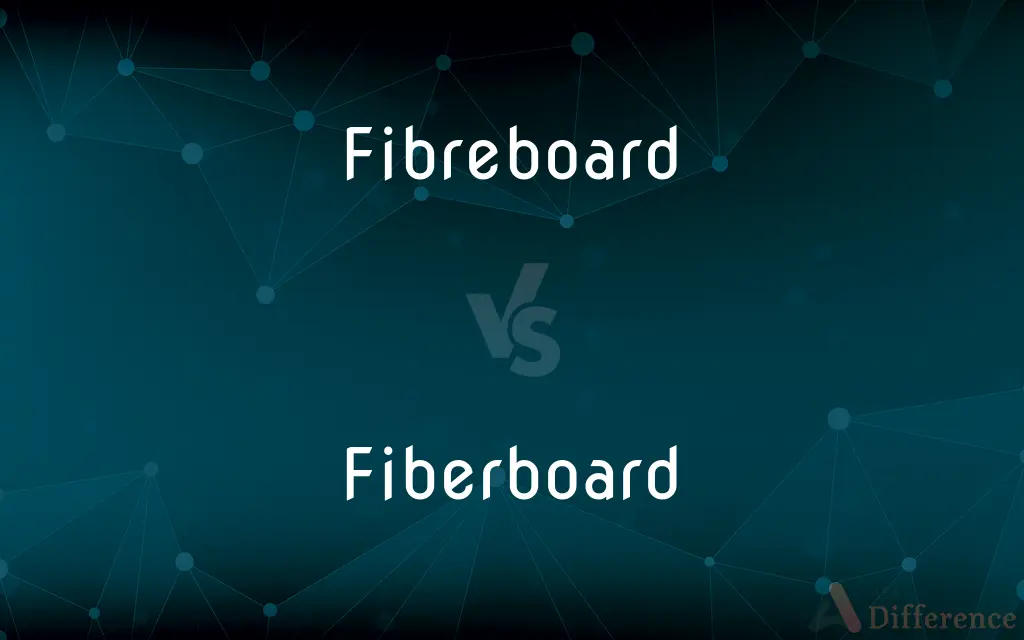Fibreboard vs. Fiberboard — What's the Difference?
By Maham Liaqat & Urooj Arif — Updated on April 3, 2024
Fibreboard and fiberboard refer to the same engineered wood product, with "fibreboard" being the British spelling and "fiberboard" the American.

Difference Between Fibreboard and Fiberboard
Table of Contents
ADVERTISEMENT
Key Differences
Fibreboard, spelled with an "e," reflects the British English convention, whereas "fiberboard," spelled with an "i," adheres to American English standards. Both terms describe a type of engineered wood made by breaking down hardwood or softwood residuals into fibers, which are then bonded with wax, resin, and heat to create panels.
The usage of either term often depends on the regional dialect of English being spoken or written. In the UK and countries using British spelling conventions, "fibreboard" is the norm. On the other hand, in the United States and areas where American English prevails, "fiberboard" is the standard spelling.
Despite the spelling difference, the manufacturing process and applications of fibreboard/fiberboard remain consistent across regions. They are widely used in the construction and furniture industries for making cabinets, shelves, and flooring underlayment due to their versatility and cost-effectiveness.
The properties such as density, strength, and moisture resistance of fibreboard/fiberboard can vary depending on the specific type, such as medium-density fibreboard (MDF), high-density fibreboard (HDF), and low-density fibreboard (LDF). This variability allows for a wide range of uses in both commercial and residential projects.
Understanding the context in which the term is used is crucial, as the choice between "fibreboard" and "fiberboard" can indicate the regional variation of English rather than any difference in the material itself. Both spellings are correct within their respective linguistic contexts.
ADVERTISEMENT
Comparison Chart
Spelling
Fibreboard
Fiberboard
Definition
Engineered wood product made from wood fibers.
Engineered wood product made from wood fibers.
Usage
Preferred in British English and related dialects.
Preferred in American English and related dialects.
Applications
Construction, furniture, underlayment.
Construction, furniture, underlayment.
Types
MDF, HDF, LDF
MDF, HDF, LDF
Compare with Definitions
Fibreboard
Engineered wood made from compressed wood fibers.
The designer opted for fibreboard for the eco-friendly furniture line.
Fiberboard
The term used in American English-speaking countries.
American manufacturers often use fiberboard in prefabricated homes.
Fibreboard
Can be finished to mimic other wood types.
The fibreboard was finished to look like oak for the cabinets.
Fiberboard
Known for its wide range of applications.
Medium-density fiberboard is popular for making durable furniture.
Fibreboard
Used in various densities for different applications.
High-density fibreboard was chosen for the flooring due to its durability.
Fiberboard
A type of engineered wood product created from wood fibers.
Fiberboard offers a cost-effective option for home DIY projects.
Fibreboard
Versatile in use, from furniture to construction.
Fibreboard panels were used extensively in the office renovation project.
Fiberboard
Employed in both residential and commercial settings.
Fiberboard insulation panels were installed in the new shopping center.
Fibreboard
Preferred in countries using British English.
In the UK, fibreboard is a common material in building construction.
Fiberboard
Suitable for a variety of finishes and treatments.
The fiberboard was treated to resist moisture in the bathroom remodel.
Fibreboard
A building material made of wood or other plant fibres compressed into boards.
Fiberboard
Fiberboard (American English) or fibreboard (British English) is a type of engineered wood product that is made out of wood fibers. Types of fiberboard (in order of increasing density) include particle board or low-density fiberboard (LDF), medium-density fiberboard (MDF), and hardboard (high-density fiberboard, HDF).
Fibreboard
Standard spelling of fiberboard
Fiberboard
A building material composed of wood chips or plant fibers bonded together and compressed into rigid sheets.
Fibreboard
Same as fiberboard.
Fiberboard
(American spelling) A material made from wood chips or shavings, which are compressed and bonded with resin and formed into stiff sheets, and used in building or making furniture.
Fibreboard
Wallboard composed of wood chips or shavings bonded together with resin and compressed into rigid sheets
Fiberboard
A type of wallboard composed of wood chips or shavings bonded together with resin and compressed into rigid sheets, calle also particle board.
Fiberboard
Wallboard composed of wood chips or shavings bonded together with resin and compressed into rigid sheets
Common Curiosities
Is there a difference between fibreboard and fiberboard?
No, there's no material difference; the terms reflect British and American English spelling variations, respectively.
Is fibreboard/fiberboard eco-friendly?
It can be considered eco-friendly as it's made from wood waste products, though the environmental impact of resins and production processes varies.
How does moisture affect fibreboard/fiberboard?
Moisture can cause swelling and damage; however, moisture-resistant types are available for use in prone areas.
Can fibreboard/fiberboard be used outdoors?
While generally used indoors due to moisture sensitivity, exterior grades treated for moisture resistance can be used outdoors.
Can I paint over fibreboard/fiberboard?
Yes, both can be painted. Surface preparation such as sanding and priming is recommended for best results.
How long does fibreboard/fiberboard last?
With proper care and in appropriate environments, it can last many years, though it generally does not have the longevity of solid wood.
How do you cut fibreboard/fiberboard?
It can be cut with standard woodworking tools, though proper dust protection and ventilation are recommended due to the fine particles.
How do I choose between MDF, HDF, and LDF?
The choice depends on the required strength, density, and application, with MDF being most common for interior furnishings.
Can fibreboard/fiberboard support heavy weights?
It depends on the density; HDF can support more weight and is suitable for flooring, while LDF and MDF may be used for less demanding applications.
Are there health concerns associated with fibreboard/fiberboard?
Concerns mainly relate to the formaldehyde used in adhesives; choosing products with low formaldehyde emissions is advisable.
Can fibreboard/fiberboard be recycled?
While challenging due to its composition and adhesives, recycling options exist but are less common than for other materials.
What's the difference in cost between fibreboard and hardwood?
Fibreboard/fiberboard is generally less expensive than solid hardwood, making it a cost-effective alternative for many applications.
How does the environmental impact of producing fibreboard compare to other woods?
Its use of wood waste reduces reliance on virgin timber, but environmental impacts of adhesive resins and production energy use should be considered.
Is fibreboard/fiberboard suitable for kitchen cabinets?
Yes, especially MDF, which provides a smooth surface for painting and is commonly used for cabinets and furniture.
What maintenance does fibreboard/fiberboard require?
It requires protection from moisture and may need refinishing or painting over time to maintain its appearance and durability.
Share Your Discovery

Previous Comparison
Beaglepuss vs. Mustache
Next Comparison
Sousaphone vs. TubaAuthor Spotlight
Written by
Maham LiaqatCo-written by
Urooj ArifUrooj is a skilled content writer at Ask Difference, known for her exceptional ability to simplify complex topics into engaging and informative content. With a passion for research and a flair for clear, concise writing, she consistently delivers articles that resonate with our diverse audience.














































